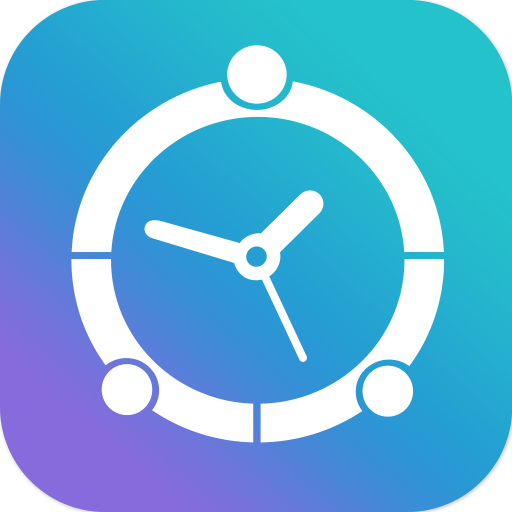FamilyTime Review: Good App But What’s the Catch?
FamilyTime Overview
I heard mixed reviews from friends and colleagues about the FamilyTime parental control app. I decided to test it for myself and see it’s something I would use.
I have five children, ranging in age from 5 to 16, and I’ve been using them as my test dummies while reviewing over 30 premium parental control apps. I picked my 13-year-old-son and installed FamilyTime on his Android phone.
The first thing that jumped out at me was the vast collection of features. I wanted to find out whether they work as advertised and, equally importantly, could my son figure out a way to bypass the restrictions, as he did with other parental control apps.
I signed up for the FamilyTime free 3-day trial and was a bit disappointed when I had to submit my credit card or PayPal information to begin.
Short On Time? Here’s What You Need to Know
Pros
- Complete remote control access of the child’s device
- Set daily time limits for the device, create time limits for specific apps, or block apps you don’t want your kids using
- One-touch communication buttons called PickMeUp and SOS to help kids send instant notifications to their parents
- Unique features teach kids the value of budgeting their phone usage time
- The parental app makes it easy to get instant updates, view reports, and check in on live locations.
Cons
- Web filter has just three categories and isn’t very flexible
- Some features are only available for iPhone and not Android and vice versa
- You can read a detailed breakdown of all the FamilyTime features below.
You can read a detailed breakdown of all the FamilyTime features below.
Features
I have mixed feelings about the features of the FamilyTime app. On the one hand, they have unique features such as a PickMeUp button and a Speed Limit Monitor (for iOS only) that I haven’t seen on any other parental control app. On the other hand, basic features such as a web filter and app monitoring are not that impressive.
Comprehensive Screen Time Addition Prevention Tools
I hate fighting with my son about how much time he spends on his phone and always telling him to stop looking at the screen and do something else. With FamilyTime, I no longer have to have these conversations.
The app has several different tools designed to limit how much time kids spend on their phones. First, there is a Schedule Screen Time and Internet Schedule:
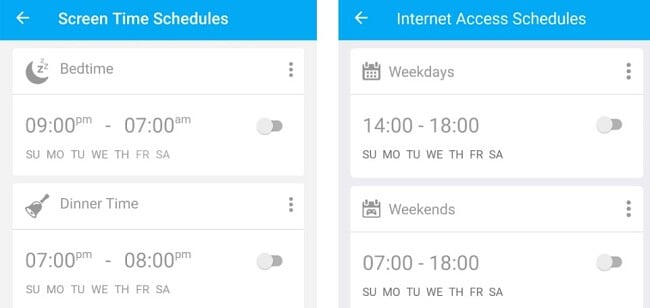
These two tools are pretty similar, but allow me to let my son know that I don’t mind if he’s using the phone to call friends, use the camera, or play games that don’t require the internet to be connected
There is also a Daily App Limit feature. This gives me the control to choose certain apps and assign a time limit on them. For example, I can set a two-hour limit on Netflix, YouTube, TikTok, and Instagram. At the end of the two hours, these apps will be blocked, but my son can still access other apps. If he doesn’t use up all his allotted time, it can be stored in the TimeBank, which I’ll talk about in a little bit.
Lastly, there is a Pause Device button that I can activate whenever I want all devices to be completely locked. I found this helpful when I wanted my son to do the dishes, even though he hadn’t used up his screen time.
A Pretty Basic Web Filter
I’ve reviewed some parental control apps, such as Qustodio, with comprehensive web filters that can be customized for each child. So, I was a bit surprised to see that the FamilyTime filter has just three categories: Porn, Drugs/Abortion, and Dating/Gambling. It also enforces SafeSearch on Google, Bing, and YouTube to filter out inappropriate search results.
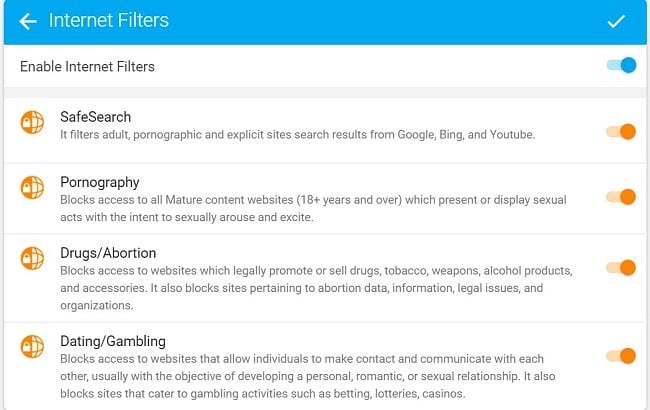
The filter does work. It blocked my son when he tried going to fantasy sports websites since it has a gambling aspect. However, I would like to see more flexibility and options. I don’t know why it combines drugs and abortions as one category and dating and gambling as another single category. These can all be separated, like Qustodio does, to give parents more flexibility in setting the rules for their house.
Know Where Your Kids are 24/7
When setting up the app on the child’s device, one of the permissions you have to agree to is giving it access to the phone’s GPS. This way, you can check in from the parental dashboard, on either your phone or computer and see exactly where your child is at any given moment.
![]()
FamilyTime also saves the location history for up to 30 days. This way, if you want to confirm that your child really went to school, the mall, or a friend’s house as they claimed, you’ll have proof. To that end, there is a geofence feature. You can set up multiple areas with a radius ranging from 150 meters to one kilometer. You will receive a notification when your child enters and leaves the area.
To set the geofence, click on the “Setting” button on the dashboard and scroll down to the Places (geofence) option. There is no limit to the number of geofences you can create. Just enter in the address or place a location pin, your preferred radius, and check the box if you want to receive notifications when your child comes and goes.
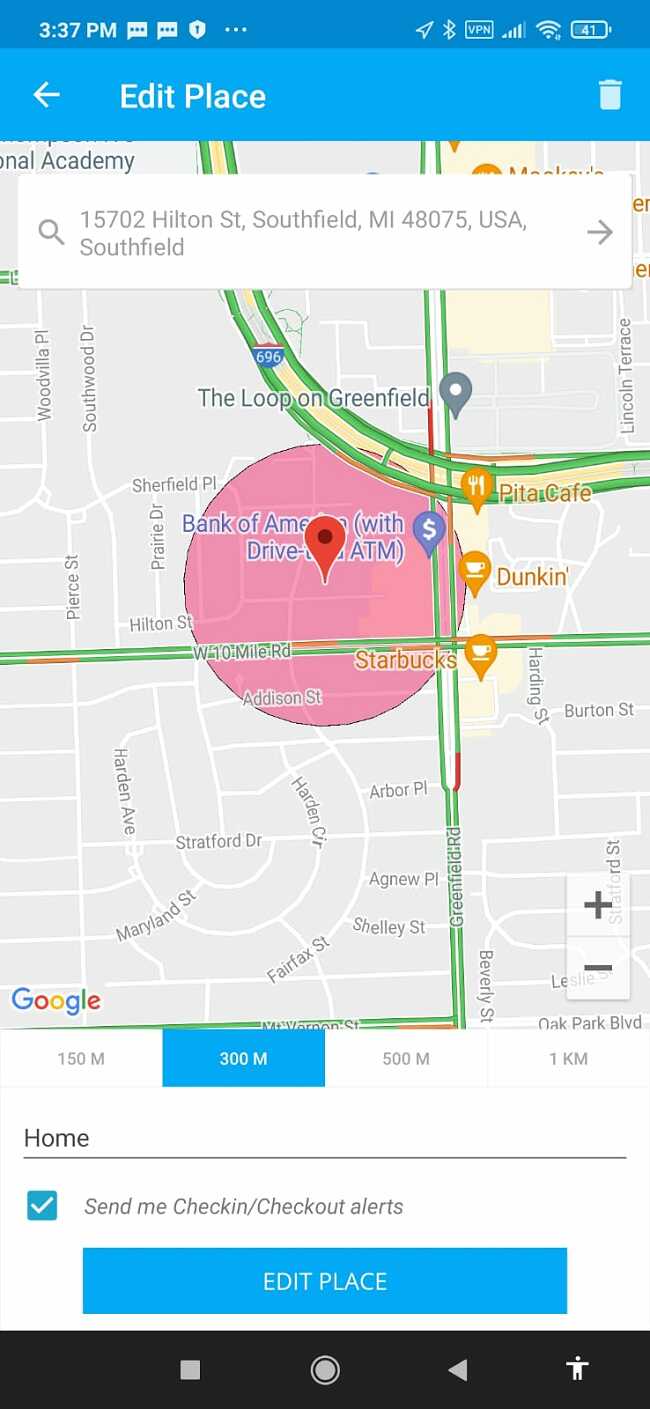
Unique Tools for Your Kids to Contact You
FamilyTime has two really smart buttons: PickMeUp and SOS Alert. These can literally be lifesavers if your child is in danger and can’t make a phone call but can access their phone. With both buttons, the parents receive an alert with a live location so that you can get to them as quickly as possible.
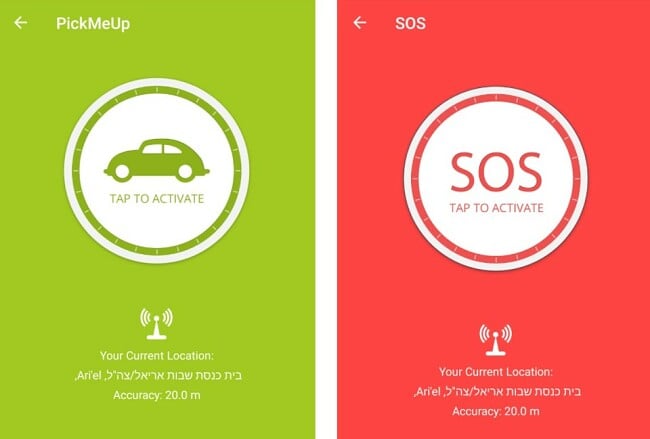
After the alert is sent, a reassuring message appears on the child’s device, telling them not to panic and what to do if they change locations. One thing I really liked is that these two buttons remain on the screen even if the device is locked.
Important: When I was testing this feature with my son, I didn’t see the alerts on the parent dashboard. I contacted customer support, and they informed me that the alerts are push notifications and only work on mobile devices.
Teaching Kids to Budget Their Time
FamilyTime has two features that are intended to teach kids the value of budgeting their time.
- The first is the TimeBank. The way it works is that if I give my son an hour to spend on YouTube and he only uses up 30 minutes, the remaining 30 minutes are added to his TimeBank and can be redeemed another day. Of course, the parent can set limits on the TimeBank as well. Otherwise, the kid can go a week without using the app and accumulate an extra 7 hours of app time.
- The FunTime feature can be used as a reward to give your kids free access to any app they want one day a week. It’s similar to the TimeBank because the unused time from their daily limit can be added to their FunTime. You can also manually set the time limit for FunTime if you want to reward the kids or need to keep them distracted for a specific time period on a given day.
You’re in Control of Your Child’s Phone
In addition to the monitoring and screen time feature, through the FamilyTime dashboard, I can remote control my child’s phone. The app blocker lets me prevent him from opening apps that I think are inappropriate. Not only that, but I can stop him from opening any new apps that he downloads until I approve them. One feature that I didn’t get a chance to test is the SpeedLimit feature. It’s geared for kids who have a license and an iPhone. The idea is that it will send an alert if your child is driving too fast. It sounds like a great feature, and hopefully, it will come to Android by the time my oldest son has his license.
Installation
The installation was a bit of a process. After I purchased my subscription package, I received an email with a password, links to the Google Play app, and installation instructions. I needed my son’s phone to download and install the app, which I did without any trouble. After creating a child profile, I had to enter a 4-digit PIN code. It’s important to keep this code a secret since the child can disable restrictions or delete the app with the PIN code.
Once the installation was complete, I sat with my son and tried out some of the features, such as the SOS and PickMeUp, but they didn’t work.
I reached out to the customer support team, and I was informed that there are certain restrictions when using the Google Play app. They suggested downloading the .apk file from the FamilyTime store instead. It would have been more convenient if the welcome email included a direct link to their store rather than the Play Store link.
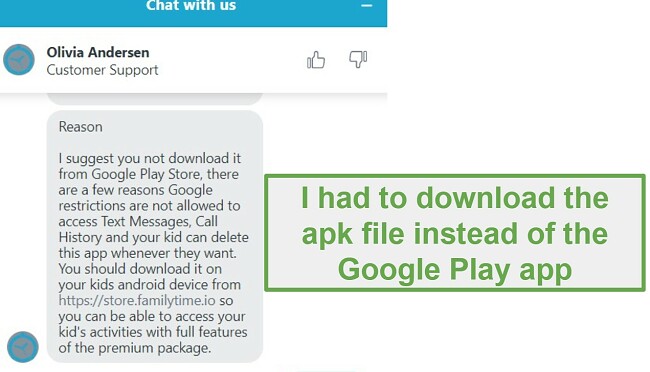
To download the app from their store, you will need to adjust your Android settings to allow installation from unknown applications. Once the app installs on the child’s phone, you will have to accept all the different permissions for the monitoring features to work. For example, if you don’t allow the app to overlay over other apps, you can’t lock the child’s phone or enforce the web filter. Without access to the contact list or SMS, FamilyTime can’t warn you if someone on your watch list contacts your child. Lastly, you will need to give Device Admin Rights to the app. Otherwise, the child can easily uninstall the app without your knowledge.
The setup tutorial is highly comprehensible, and whenever adjustments to the settings are required, you can simply click on the “Take Me There” link. This link will promptly direct you to the appropriate section within your settings menu.
Installing the parental app is simple. You can download it directly from the Play or App Store without any issues.
Ease of Use
You can log in to the dashboard from anywhere on the PC or download the parental app and use it on your phone. I found the mobile version to have a more modern design, and it was easier to use.
When you first open the dashboard, it will list all the devices you’re monitoring, how much time the kids have been on their phones, and how much time is remaining.
To see more information, click on the Reports button. While it isn’t the prettiest layout, you can quickly see all the important stats, such as how many SMS messages they received, how long they were on the phone, time spent on apps, how much time is saved for the TimeBank, and more. You can click on each square for more information about each topic, and the data is stored for seven days.
To make adjustments to the filter, screen time limits, and more, just click on the Settings button, and you’ll see a list of all the features broken up into three sections:
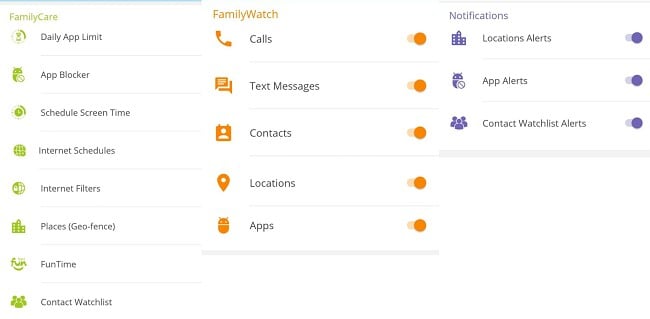
- FamilyWatch: You can toggle on or off whether you want to monitor phone calls, texts, contacts lists, live locations, and apps.
- FamilyCare: This is where you can set limits and restrictions on time and app usage.
- Notification: Select whether you want to receive alerts based on location, apps, or specific contacts.
For the child, the app is simple. They can open the app at any time and see how much time they have remaining and what is saved up for the TimeBank. They can also tap the PickMeUp or SOS alert buttons in case they need to reach you quickly.
The child app can’t be deleted or deactivated without knowing the four-digit PIN code that you use during the installation process. So, make sure that it’s not an easy number to guess, such as a birthday or anniversary.
Support
To say I was impressed with the 24/7 live chat customer support would be an understatement. I turned to them several times after downloading the app with questions about installing the app, different features, and canceling my account.
The people I chatted with were helpful, professional, and were able to answer all my questions.

In addition to the live chat, FamilyTime has a detailed FAQ and a ticket system that they answer within one business day.
FAQ
Is FamilyTime secure?
After reading through the company Privacy Policy and Terms and Conditions, I was satisfied that my child’s personal data wouldn’t be shared or sold to third parties. From a technical standpoint, the FamilyTime data servers are encrypted, making them unreadable to anyone with a decryption key.
It is important to download the FamilyTime app from their official site and to avoid trying to find a “cracked” or free version from a download site.
Does FamilyTime have a free app?
There is a very limited free version that includes call tracking, view app usages, and the SOS button. If you want the premium features, such as setting time restrictions, PickMeUp, web filter, location tracking, and more, you’ll need to purchase a subscription. If you’re still not sure, try it risk-free for 3 days.
What are the TimeBank and FunTime features?
These are two unique features that work together to reward your kids for budgeting their time. Kids can save their unused time and add it to their TimeBank to use at a later time. FunTime allows you to grant the kids access to use all apps freely on a day that you choose, by letting them use the remaining time they have saved from Daily Limit.
Can I lock my kids’ phones remotely?
Yes. There are several different ways to block your kids’ access to their phones. In addition to creating schedules, daily limits, and app limits, you can simply pause all devices at any time from your parental dashboard. The phone will still be able to accept phone calls and press the PickMeUp and SOS alert buttons.
What kind of reporting can I see on the parental dashboard?
I was able to see how much time my son was spending on his phone, how long he used each app, his call log, and SMS messages. I could also check his live location, the apps installed on his phone, and how much time is stored in the TimeBank. What you don’t see is what videos he’s searching for on YouTube, what he’s doing on social media, or what websites they visit. If you want that level of reporting, check out Qustodio, which has the best monitoring features I’ve seen.
Pricing
There are four FamilyTime subscription plans. Each one gives access to all the premium features, with the only difference being whether you want protection for unlimited devices or 1, 2, or 5 devices. None of the plans are expensive by any measure, and at most, they will cost you a few dollars a month.
Each plan also comes with a 3-day free trial. I was a bit annoyed that I had to enter my credit card information to get started because it put pressure on me to remember to cancel my account before the trial period ends. I couldn’t find the cancel account option on my dashboard. I contacted customer service to see how to cancel my account, and I was told that it couldn’t be done through the dashboard. There are two ways to cancel your account:
- Send an email to the billing department.
- In the original email you receive when creating your account, there is the option to cancel your subscription. This made me happy, as I didn’t have to talk to a retention agent who would try and convince me not to cancel my account. Click on the Review your subscription link in your email, and a new page will open. Just click on the Cancel Account button, and your account will immediately be
closed.
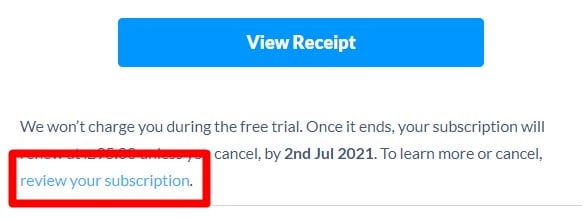
Bottom Line
FamilyTime is a unique parental control app with nearly all the features I look for to monitor my kid’s screen time activities. The main area of concern for me was the web filter, which seemed pretty basic. I would recommend checking out Qustodio if a web filter is a high-value feature for you.
Otherwise, with several flexible screen time tools, unique contact options like PickMeUp and SOS, and the 2 time-budgeting features, FamilyTime is a solid choice. Take advantage of the free 3-day trial and get access to all the premium features, so you can test it out and see if it’s the right parental control app for your family.
